ACC200 Management Accounting: Job Costing, Overheads, and ABC Analysis
VerifiedAdded on 2023/03/23
|13
|2694
|45
Report
AI Summary
This report provides a comprehensive analysis of job costing and activity-based costing (ABC) within the context of management accounting. It evaluates the applicability of job costing in various business scenarios and calculates the work-in-progress inventory and finished goods inventory values. The report also addresses the treatment of over-applied and under-applied overheads, comparing two alternative accounting methods. Furthermore, it highlights the advantages of ABC over traditional costing methods, emphasizing its ability to improve the accuracy and relevance of expense allocation by dividing production processes into different activities and using cost drivers. The analysis includes practical calculations and theoretical evaluations, concluding with the benefits of implementing ABC to enhance pricing strategies.
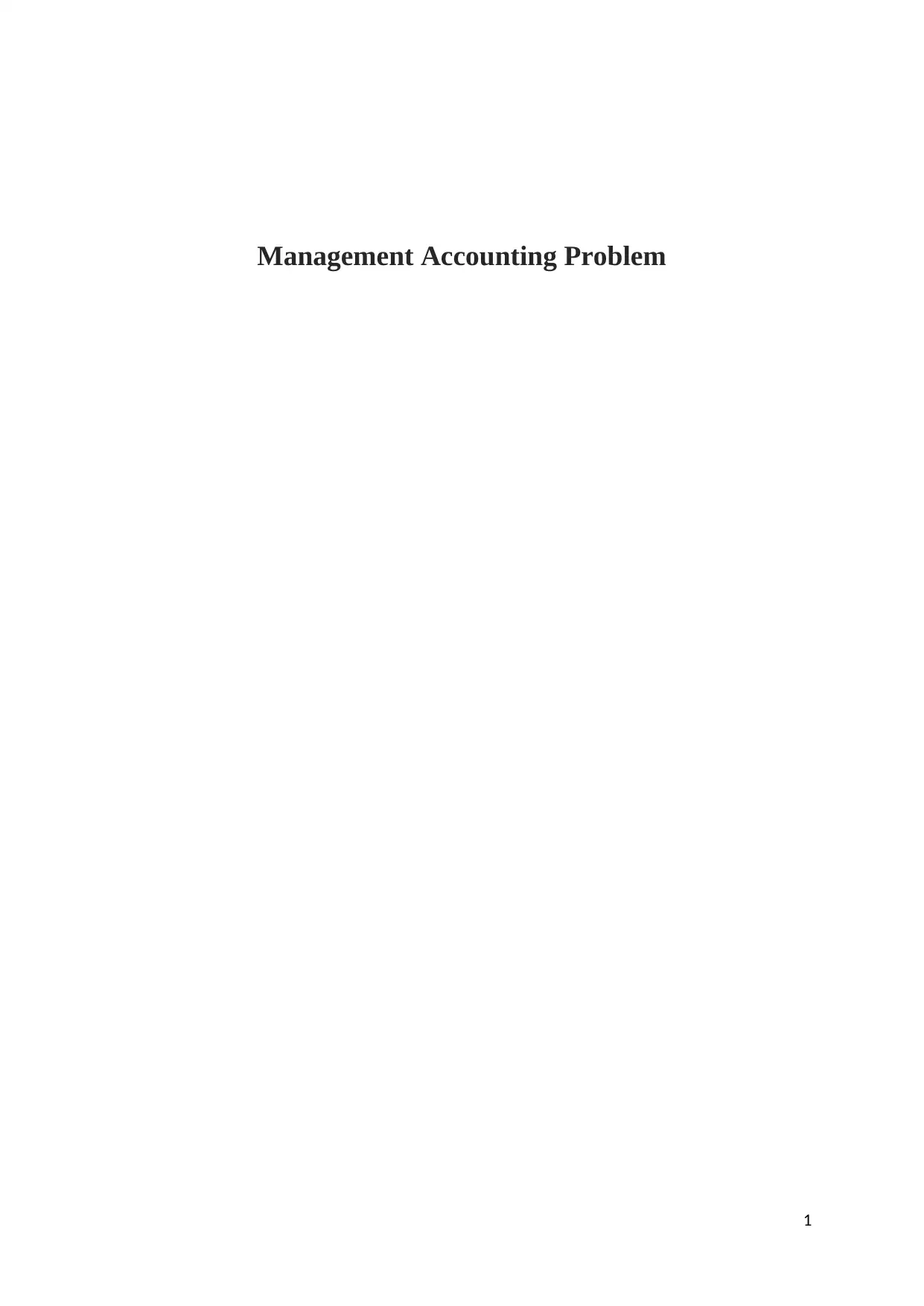
Management Accounting Problem
1
1
Paraphrase This Document
Need a fresh take? Get an instant paraphrase of this document with our AI Paraphraser
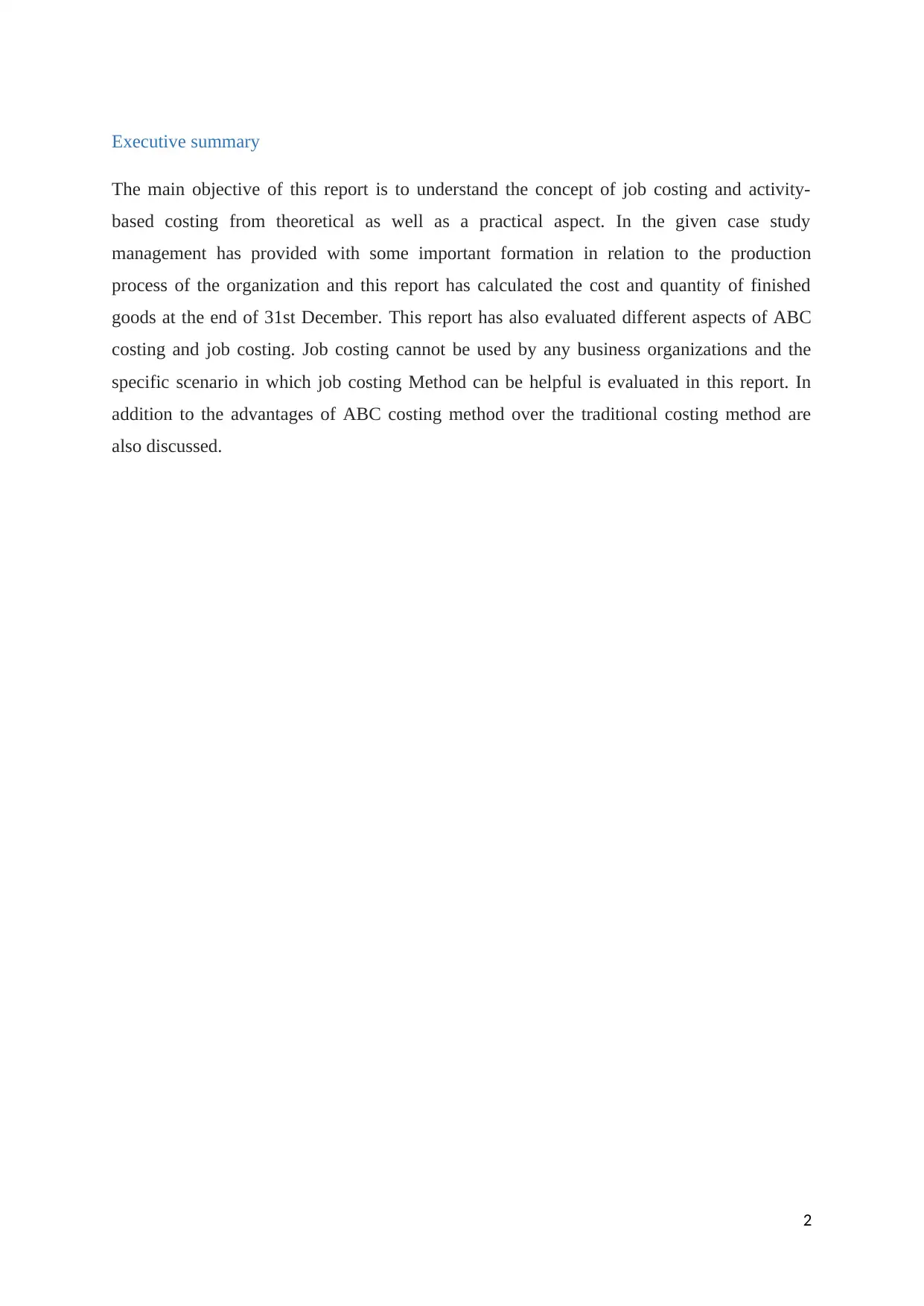
Executive summary
The main objective of this report is to understand the concept of job costing and activity-
based costing from theoretical as well as a practical aspect. In the given case study
management has provided with some important formation in relation to the production
process of the organization and this report has calculated the cost and quantity of finished
goods at the end of 31st December. This report has also evaluated different aspects of ABC
costing and job costing. Job costing cannot be used by any business organizations and the
specific scenario in which job costing Method can be helpful is evaluated in this report. In
addition to the advantages of ABC costing method over the traditional costing method are
also discussed.
2
The main objective of this report is to understand the concept of job costing and activity-
based costing from theoretical as well as a practical aspect. In the given case study
management has provided with some important formation in relation to the production
process of the organization and this report has calculated the cost and quantity of finished
goods at the end of 31st December. This report has also evaluated different aspects of ABC
costing and job costing. Job costing cannot be used by any business organizations and the
specific scenario in which job costing Method can be helpful is evaluated in this report. In
addition to the advantages of ABC costing method over the traditional costing method are
also discussed.
2
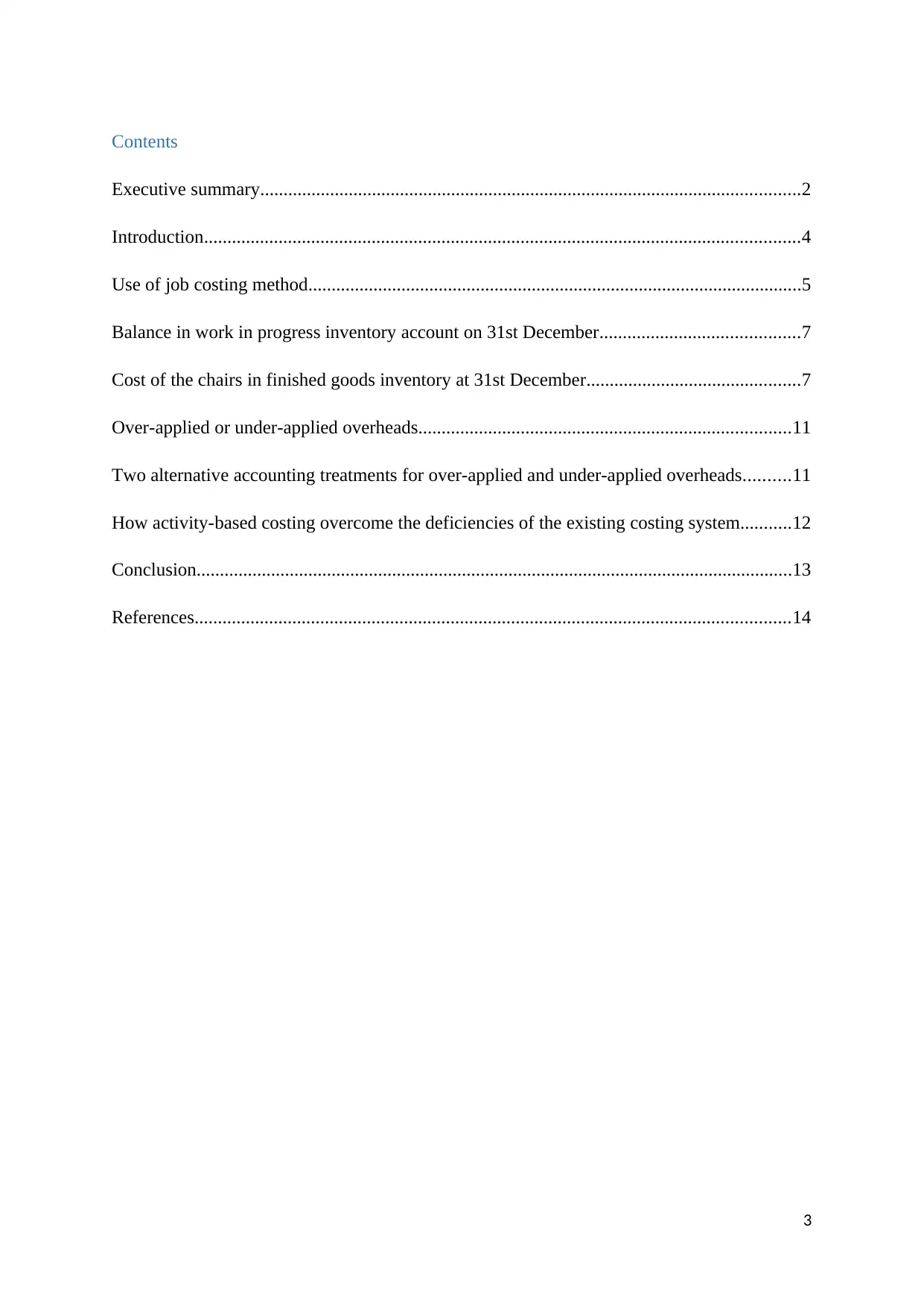
Contents
Executive summary....................................................................................................................2
Introduction................................................................................................................................4
Use of job costing method..........................................................................................................5
Balance in work in progress inventory account on 31st December...........................................7
Cost of the chairs in finished goods inventory at 31st December..............................................7
Over-applied or under-applied overheads................................................................................11
Two alternative accounting treatments for over-applied and under-applied overheads..........11
How activity-based costing overcome the deficiencies of the existing costing system...........12
Conclusion................................................................................................................................13
References................................................................................................................................14
3
Executive summary....................................................................................................................2
Introduction................................................................................................................................4
Use of job costing method..........................................................................................................5
Balance in work in progress inventory account on 31st December...........................................7
Cost of the chairs in finished goods inventory at 31st December..............................................7
Over-applied or under-applied overheads................................................................................11
Two alternative accounting treatments for over-applied and under-applied overheads..........11
How activity-based costing overcome the deficiencies of the existing costing system...........12
Conclusion................................................................................................................................13
References................................................................................................................................14
3
⊘ This is a preview!⊘
Do you want full access?
Subscribe today to unlock all pages.

Trusted by 1+ million students worldwide
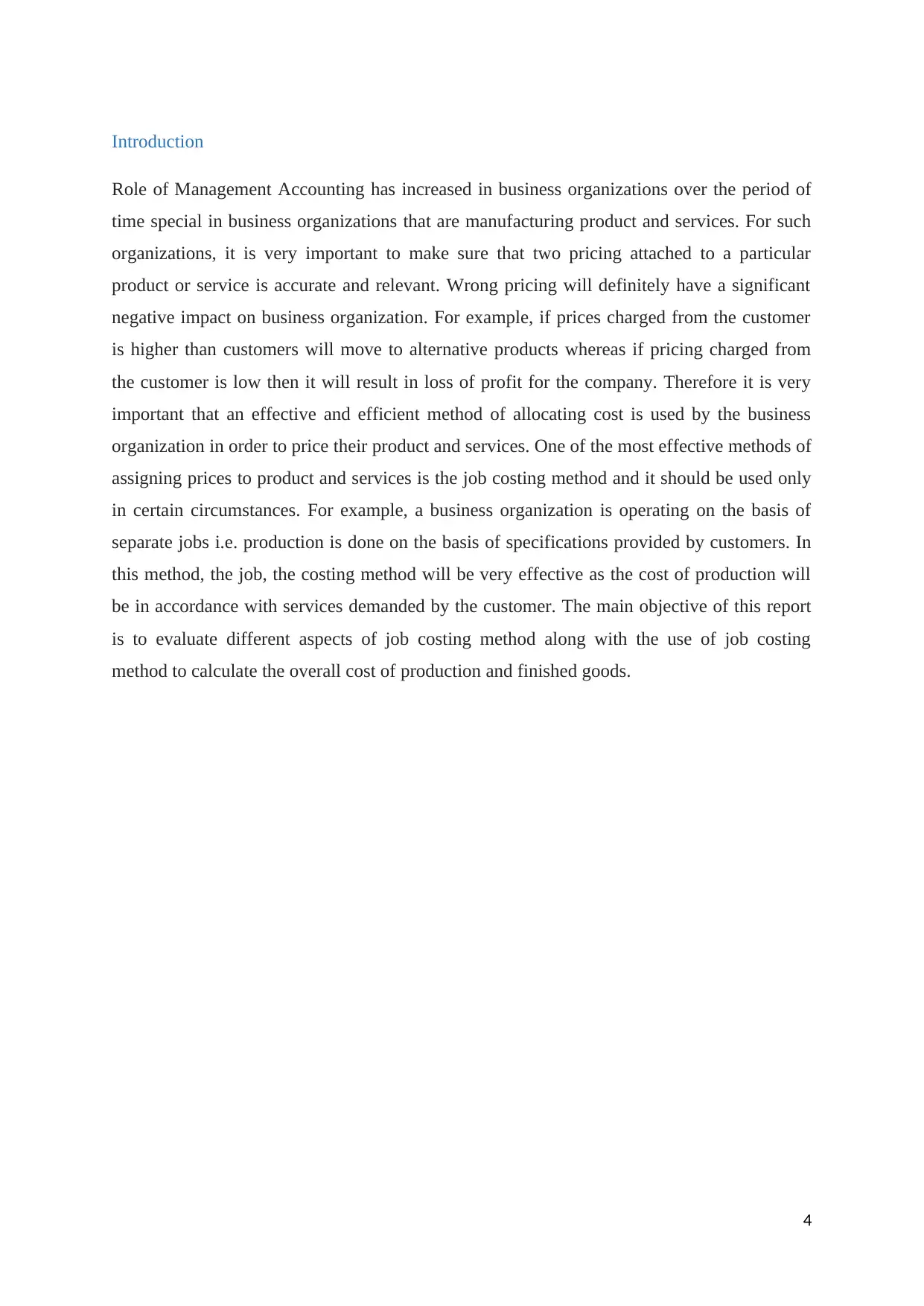
Introduction
Role of Management Accounting has increased in business organizations over the period of
time special in business organizations that are manufacturing product and services. For such
organizations, it is very important to make sure that two pricing attached to a particular
product or service is accurate and relevant. Wrong pricing will definitely have a significant
negative impact on business organization. For example, if prices charged from the customer
is higher than customers will move to alternative products whereas if pricing charged from
the customer is low then it will result in loss of profit for the company. Therefore it is very
important that an effective and efficient method of allocating cost is used by the business
organization in order to price their product and services. One of the most effective methods of
assigning prices to product and services is the job costing method and it should be used only
in certain circumstances. For example, a business organization is operating on the basis of
separate jobs i.e. production is done on the basis of specifications provided by customers. In
this method, the job, the costing method will be very effective as the cost of production will
be in accordance with services demanded by the customer. The main objective of this report
is to evaluate different aspects of job costing method along with the use of job costing
method to calculate the overall cost of production and finished goods.
4
Role of Management Accounting has increased in business organizations over the period of
time special in business organizations that are manufacturing product and services. For such
organizations, it is very important to make sure that two pricing attached to a particular
product or service is accurate and relevant. Wrong pricing will definitely have a significant
negative impact on business organization. For example, if prices charged from the customer
is higher than customers will move to alternative products whereas if pricing charged from
the customer is low then it will result in loss of profit for the company. Therefore it is very
important that an effective and efficient method of allocating cost is used by the business
organization in order to price their product and services. One of the most effective methods of
assigning prices to product and services is the job costing method and it should be used only
in certain circumstances. For example, a business organization is operating on the basis of
separate jobs i.e. production is done on the basis of specifications provided by customers. In
this method, the job, the costing method will be very effective as the cost of production will
be in accordance with services demanded by the customer. The main objective of this report
is to evaluate different aspects of job costing method along with the use of job costing
method to calculate the overall cost of production and finished goods.
4
Paraphrase This Document
Need a fresh take? Get an instant paraphrase of this document with our AI Paraphraser
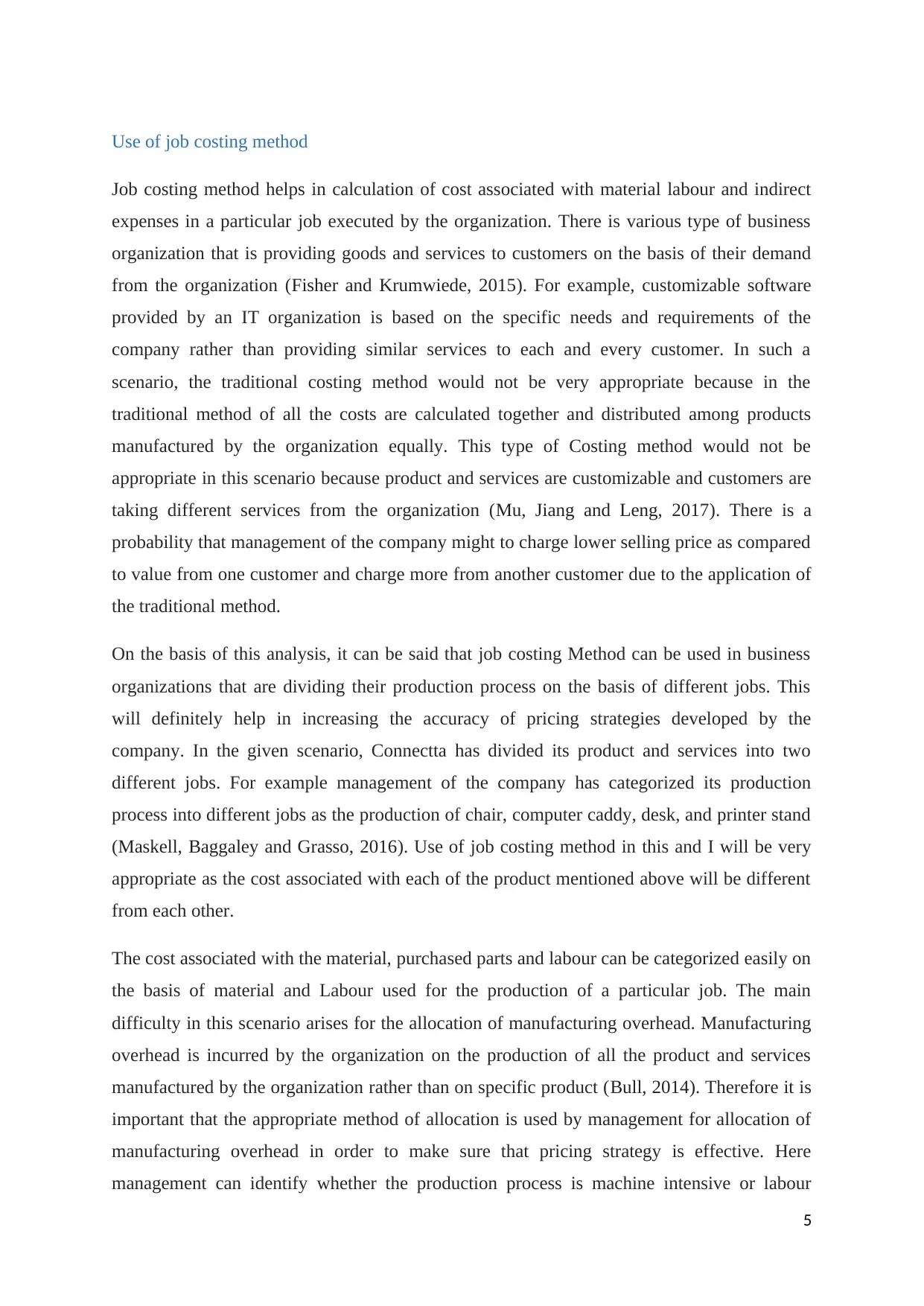
Use of job costing method
Job costing method helps in calculation of cost associated with material labour and indirect
expenses in a particular job executed by the organization. There is various type of business
organization that is providing goods and services to customers on the basis of their demand
from the organization (Fisher and Krumwiede, 2015). For example, customizable software
provided by an IT organization is based on the specific needs and requirements of the
company rather than providing similar services to each and every customer. In such a
scenario, the traditional costing method would not be very appropriate because in the
traditional method of all the costs are calculated together and distributed among products
manufactured by the organization equally. This type of Costing method would not be
appropriate in this scenario because product and services are customizable and customers are
taking different services from the organization (Mu, Jiang and Leng, 2017). There is a
probability that management of the company might to charge lower selling price as compared
to value from one customer and charge more from another customer due to the application of
the traditional method.
On the basis of this analysis, it can be said that job costing Method can be used in business
organizations that are dividing their production process on the basis of different jobs. This
will definitely help in increasing the accuracy of pricing strategies developed by the
company. In the given scenario, Connectta has divided its product and services into two
different jobs. For example management of the company has categorized its production
process into different jobs as the production of chair, computer caddy, desk, and printer stand
(Maskell, Baggaley and Grasso, 2016). Use of job costing method in this and I will be very
appropriate as the cost associated with each of the product mentioned above will be different
from each other.
The cost associated with the material, purchased parts and labour can be categorized easily on
the basis of material and Labour used for the production of a particular job. The main
difficulty in this scenario arises for the allocation of manufacturing overhead. Manufacturing
overhead is incurred by the organization on the production of all the product and services
manufactured by the organization rather than on specific product (Bull, 2014). Therefore it is
important that the appropriate method of allocation is used by management for allocation of
manufacturing overhead in order to make sure that pricing strategy is effective. Here
management can identify whether the production process is machine intensive or labour
5
Job costing method helps in calculation of cost associated with material labour and indirect
expenses in a particular job executed by the organization. There is various type of business
organization that is providing goods and services to customers on the basis of their demand
from the organization (Fisher and Krumwiede, 2015). For example, customizable software
provided by an IT organization is based on the specific needs and requirements of the
company rather than providing similar services to each and every customer. In such a
scenario, the traditional costing method would not be very appropriate because in the
traditional method of all the costs are calculated together and distributed among products
manufactured by the organization equally. This type of Costing method would not be
appropriate in this scenario because product and services are customizable and customers are
taking different services from the organization (Mu, Jiang and Leng, 2017). There is a
probability that management of the company might to charge lower selling price as compared
to value from one customer and charge more from another customer due to the application of
the traditional method.
On the basis of this analysis, it can be said that job costing Method can be used in business
organizations that are dividing their production process on the basis of different jobs. This
will definitely help in increasing the accuracy of pricing strategies developed by the
company. In the given scenario, Connectta has divided its product and services into two
different jobs. For example management of the company has categorized its production
process into different jobs as the production of chair, computer caddy, desk, and printer stand
(Maskell, Baggaley and Grasso, 2016). Use of job costing method in this and I will be very
appropriate as the cost associated with each of the product mentioned above will be different
from each other.
The cost associated with the material, purchased parts and labour can be categorized easily on
the basis of material and Labour used for the production of a particular job. The main
difficulty in this scenario arises for the allocation of manufacturing overhead. Manufacturing
overhead is incurred by the organization on the production of all the product and services
manufactured by the organization rather than on specific product (Bull, 2014). Therefore it is
important that the appropriate method of allocation is used by management for allocation of
manufacturing overhead in order to make sure that pricing strategy is effective. Here
management can identify whether the production process is machine intensive or labour
5
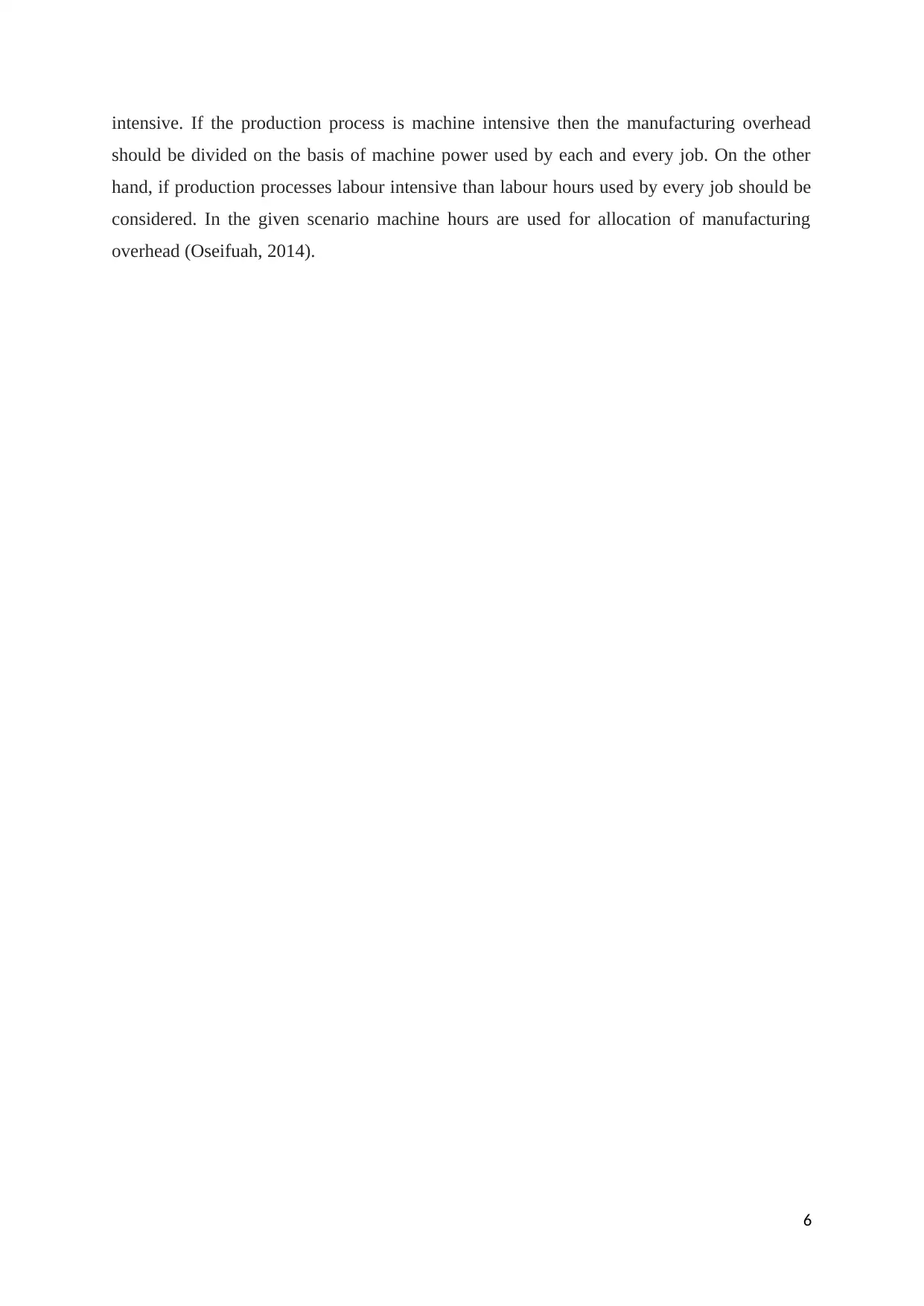
intensive. If the production process is machine intensive then the manufacturing overhead
should be divided on the basis of machine power used by each and every job. On the other
hand, if production processes labour intensive than labour hours used by every job should be
considered. In the given scenario machine hours are used for allocation of manufacturing
overhead (Oseifuah, 2014).
6
should be divided on the basis of machine power used by each and every job. On the other
hand, if production processes labour intensive than labour hours used by every job should be
considered. In the given scenario machine hours are used for allocation of manufacturing
overhead (Oseifuah, 2014).
6
⊘ This is a preview!⊘
Do you want full access?
Subscribe today to unlock all pages.

Trusted by 1+ million students worldwide
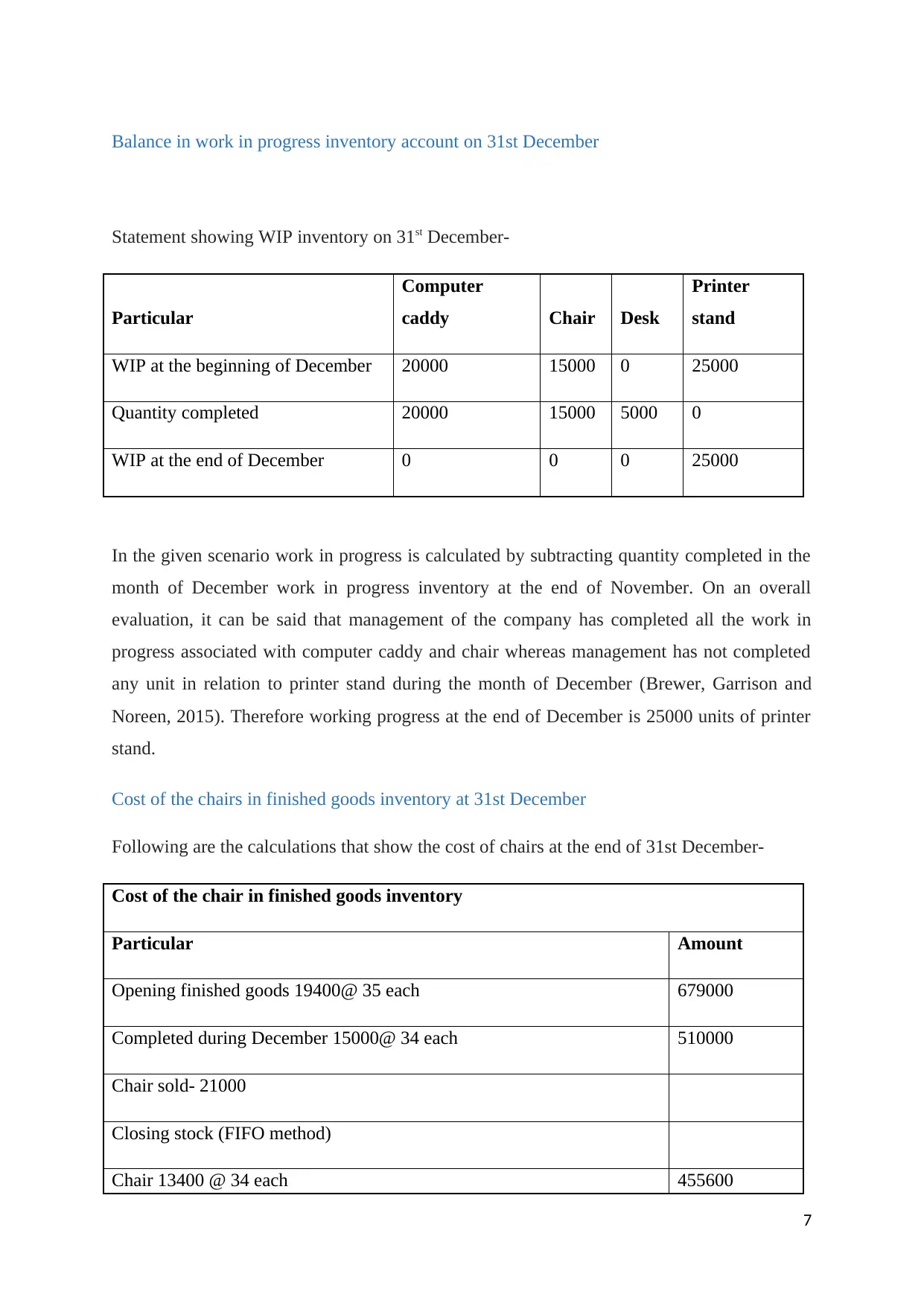
Balance in work in progress inventory account on 31st December
Statement showing WIP inventory on 31st December-
Particular
Computer
caddy Chair Desk
Printer
stand
WIP at the beginning of December 20000 15000 0 25000
Quantity completed 20000 15000 5000 0
WIP at the end of December 0 0 0 25000
In the given scenario work in progress is calculated by subtracting quantity completed in the
month of December work in progress inventory at the end of November. On an overall
evaluation, it can be said that management of the company has completed all the work in
progress associated with computer caddy and chair whereas management has not completed
any unit in relation to printer stand during the month of December (Brewer, Garrison and
Noreen, 2015). Therefore working progress at the end of December is 25000 units of printer
stand.
Cost of the chairs in finished goods inventory at 31st December
Following are the calculations that show the cost of chairs at the end of 31st December-
Cost of the chair in finished goods inventory
Particular Amount
Opening finished goods 19400@ 35 each 679000
Completed during December 15000@ 34 each 510000
Chair sold- 21000
Closing stock (FIFO method)
Chair 13400 @ 34 each 455600
7
Statement showing WIP inventory on 31st December-
Particular
Computer
caddy Chair Desk
Printer
stand
WIP at the beginning of December 20000 15000 0 25000
Quantity completed 20000 15000 5000 0
WIP at the end of December 0 0 0 25000
In the given scenario work in progress is calculated by subtracting quantity completed in the
month of December work in progress inventory at the end of November. On an overall
evaluation, it can be said that management of the company has completed all the work in
progress associated with computer caddy and chair whereas management has not completed
any unit in relation to printer stand during the month of December (Brewer, Garrison and
Noreen, 2015). Therefore working progress at the end of December is 25000 units of printer
stand.
Cost of the chairs in finished goods inventory at 31st December
Following are the calculations that show the cost of chairs at the end of 31st December-
Cost of the chair in finished goods inventory
Particular Amount
Opening finished goods 19400@ 35 each 679000
Completed during December 15000@ 34 each 510000
Chair sold- 21000
Closing stock (FIFO method)
Chair 13400 @ 34 each 455600
7
Paraphrase This Document
Need a fresh take? Get an instant paraphrase of this document with our AI Paraphraser
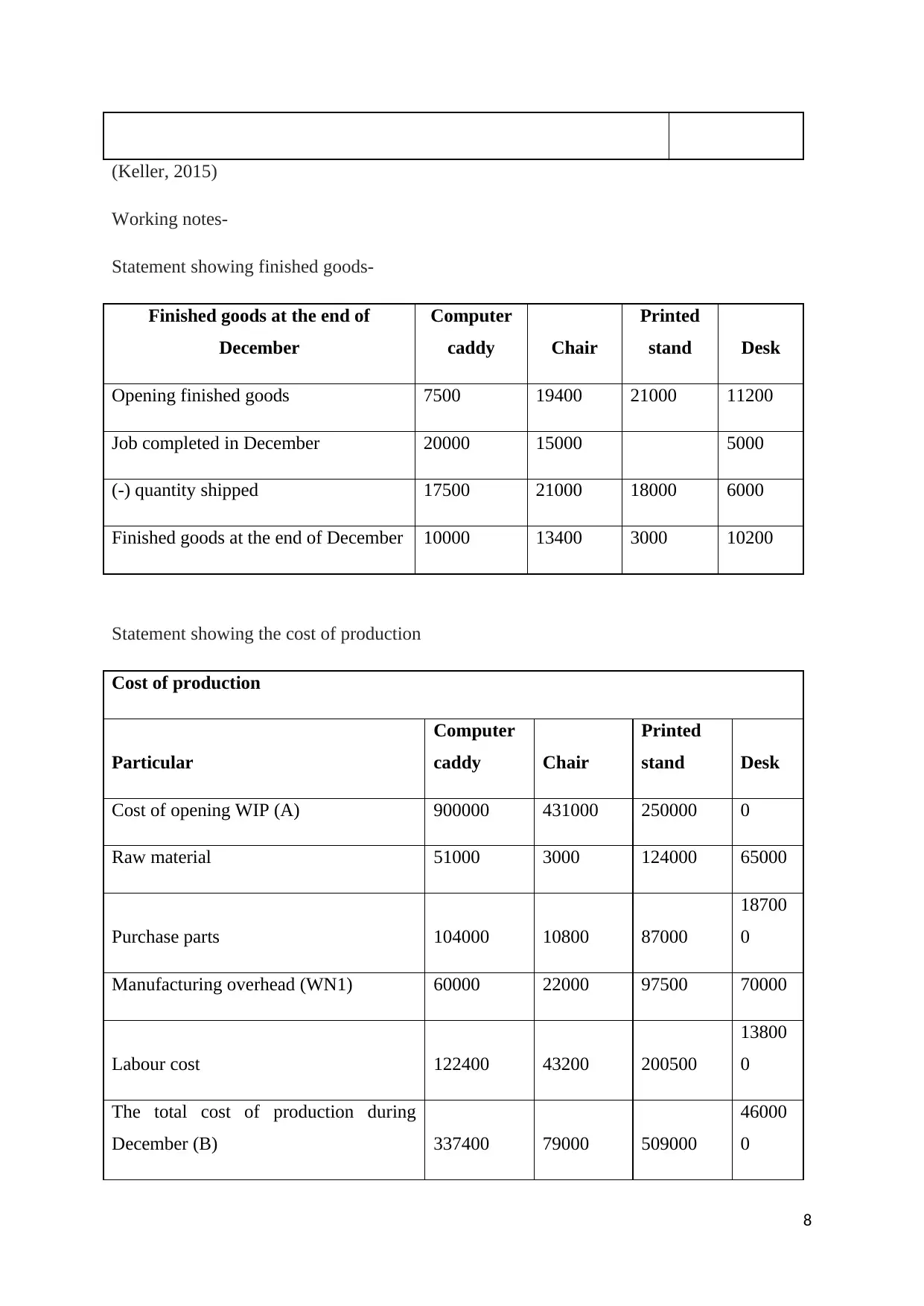
(Keller, 2015)
Working notes-
Statement showing finished goods-
Finished goods at the end of
December
Computer
caddy Chair
Printed
stand Desk
Opening finished goods 7500 19400 21000 11200
Job completed in December 20000 15000 5000
(-) quantity shipped 17500 21000 18000 6000
Finished goods at the end of December 10000 13400 3000 10200
Statement showing the cost of production
Cost of production
Particular
Computer
caddy Chair
Printed
stand Desk
Cost of opening WIP (A) 900000 431000 250000 0
Raw material 51000 3000 124000 65000
Purchase parts 104000 10800 87000
18700
0
Manufacturing overhead (WN1) 60000 22000 97500 70000
Labour cost 122400 43200 200500
13800
0
The total cost of production during
December (B) 337400 79000 509000
46000
0
8
Working notes-
Statement showing finished goods-
Finished goods at the end of
December
Computer
caddy Chair
Printed
stand Desk
Opening finished goods 7500 19400 21000 11200
Job completed in December 20000 15000 5000
(-) quantity shipped 17500 21000 18000 6000
Finished goods at the end of December 10000 13400 3000 10200
Statement showing the cost of production
Cost of production
Particular
Computer
caddy Chair
Printed
stand Desk
Cost of opening WIP (A) 900000 431000 250000 0
Raw material 51000 3000 124000 65000
Purchase parts 104000 10800 87000
18700
0
Manufacturing overhead (WN1) 60000 22000 97500 70000
Labour cost 122400 43200 200500
13800
0
The total cost of production during
December (B) 337400 79000 509000
46000
0
8
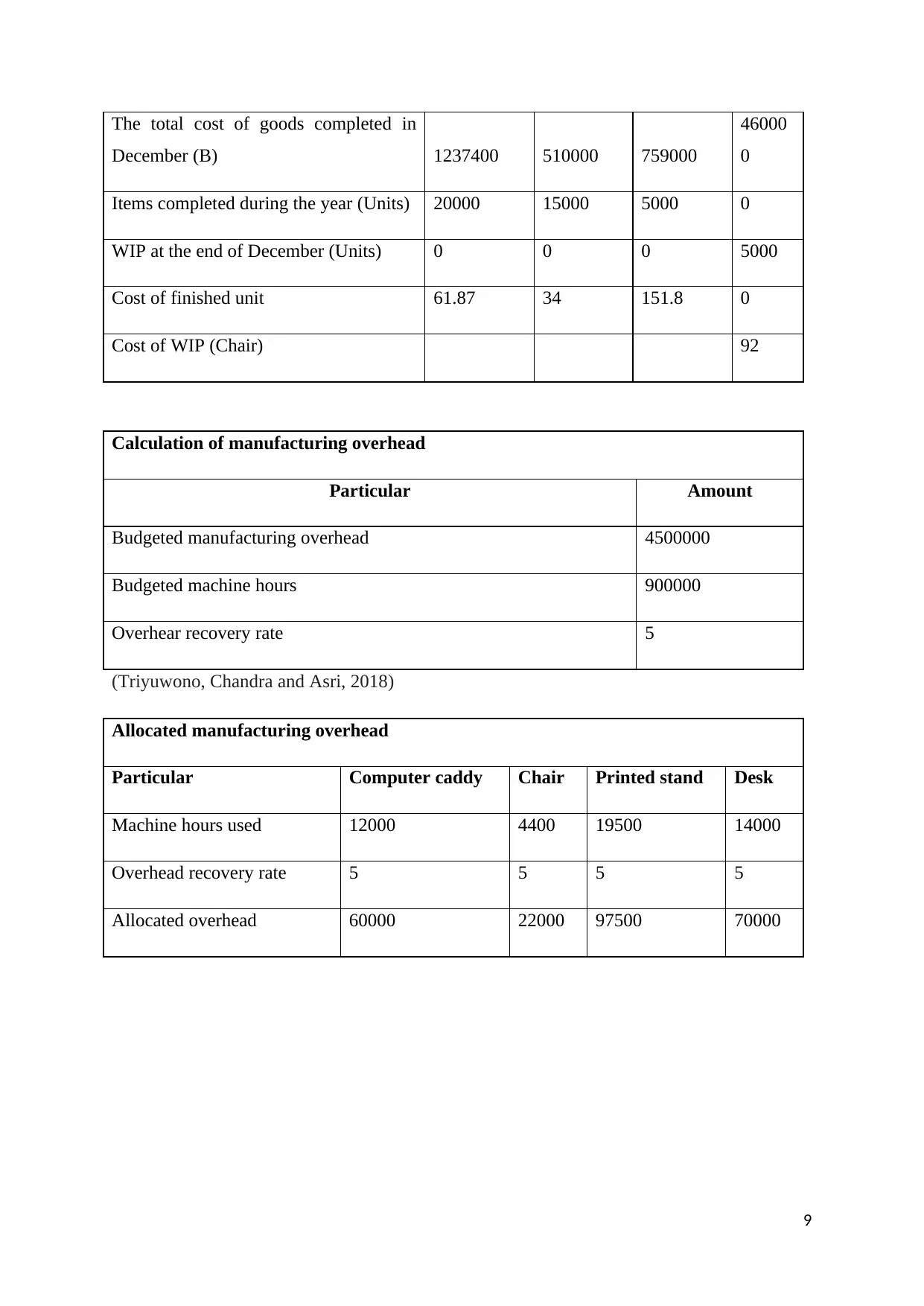
The total cost of goods completed in
December (B) 1237400 510000 759000
46000
0
Items completed during the year (Units) 20000 15000 5000 0
WIP at the end of December (Units) 0 0 0 5000
Cost of finished unit 61.87 34 151.8 0
Cost of WIP (Chair) 92
Calculation of manufacturing overhead
Particular Amount
Budgeted manufacturing overhead 4500000
Budgeted machine hours 900000
Overhear recovery rate 5
(Triyuwono, Chandra and Asri, 2018)
Allocated manufacturing overhead
Particular Computer caddy Chair Printed stand Desk
Machine hours used 12000 4400 19500 14000
Overhead recovery rate 5 5 5 5
Allocated overhead 60000 22000 97500 70000
9
December (B) 1237400 510000 759000
46000
0
Items completed during the year (Units) 20000 15000 5000 0
WIP at the end of December (Units) 0 0 0 5000
Cost of finished unit 61.87 34 151.8 0
Cost of WIP (Chair) 92
Calculation of manufacturing overhead
Particular Amount
Budgeted manufacturing overhead 4500000
Budgeted machine hours 900000
Overhear recovery rate 5
(Triyuwono, Chandra and Asri, 2018)
Allocated manufacturing overhead
Particular Computer caddy Chair Printed stand Desk
Machine hours used 12000 4400 19500 14000
Overhead recovery rate 5 5 5 5
Allocated overhead 60000 22000 97500 70000
9
⊘ This is a preview!⊘
Do you want full access?
Subscribe today to unlock all pages.

Trusted by 1+ million students worldwide
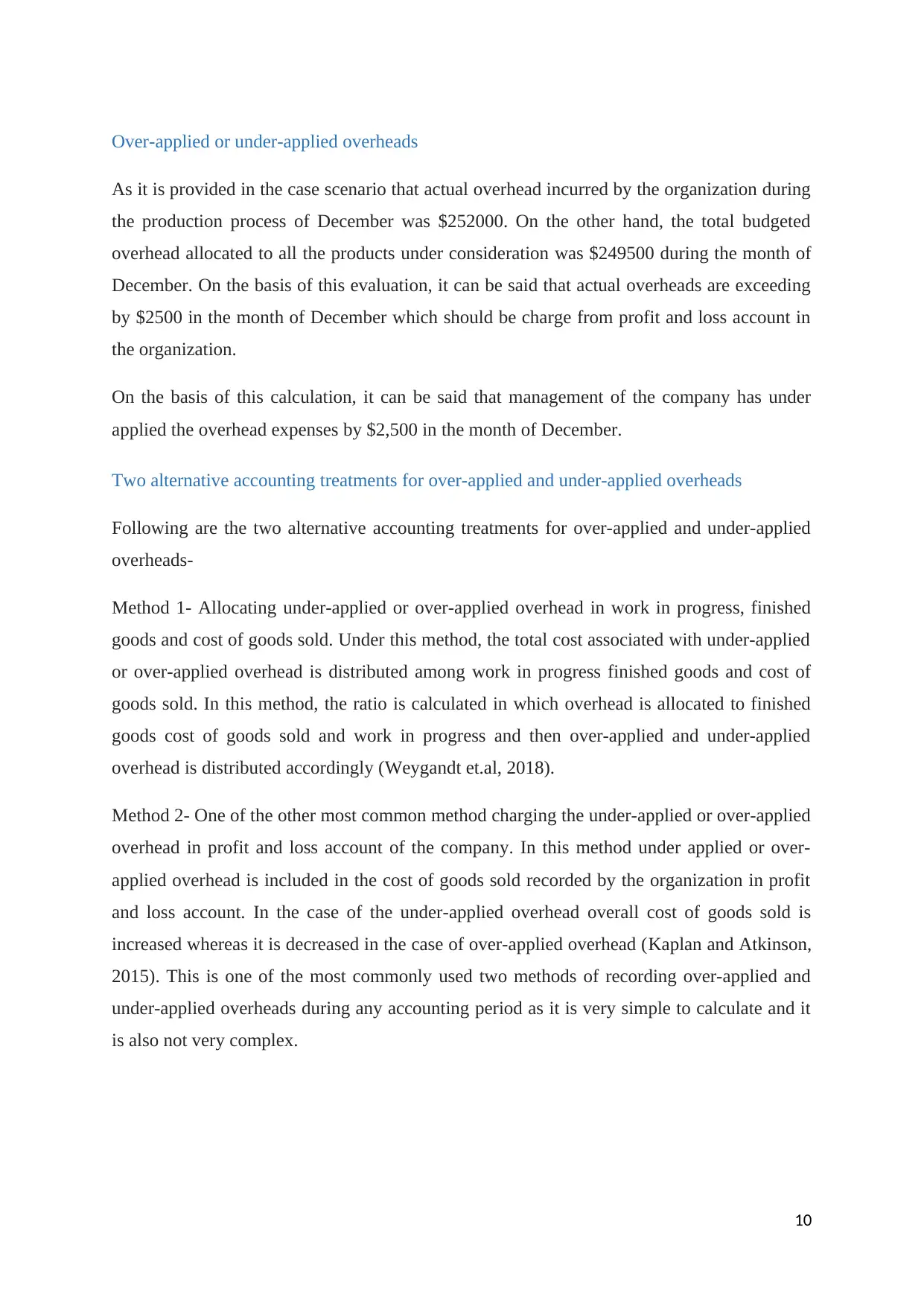
Over-applied or under-applied overheads
As it is provided in the case scenario that actual overhead incurred by the organization during
the production process of December was $252000. On the other hand, the total budgeted
overhead allocated to all the products under consideration was $249500 during the month of
December. On the basis of this evaluation, it can be said that actual overheads are exceeding
by $2500 in the month of December which should be charge from profit and loss account in
the organization.
On the basis of this calculation, it can be said that management of the company has under
applied the overhead expenses by $2,500 in the month of December.
Two alternative accounting treatments for over-applied and under-applied overheads
Following are the two alternative accounting treatments for over-applied and under-applied
overheads-
Method 1- Allocating under-applied or over-applied overhead in work in progress, finished
goods and cost of goods sold. Under this method, the total cost associated with under-applied
or over-applied overhead is distributed among work in progress finished goods and cost of
goods sold. In this method, the ratio is calculated in which overhead is allocated to finished
goods cost of goods sold and work in progress and then over-applied and under-applied
overhead is distributed accordingly (Weygandt et.al, 2018).
Method 2- One of the other most common method charging the under-applied or over-applied
overhead in profit and loss account of the company. In this method under applied or over-
applied overhead is included in the cost of goods sold recorded by the organization in profit
and loss account. In the case of the under-applied overhead overall cost of goods sold is
increased whereas it is decreased in the case of over-applied overhead (Kaplan and Atkinson,
2015). This is one of the most commonly used two methods of recording over-applied and
under-applied overheads during any accounting period as it is very simple to calculate and it
is also not very complex.
10
As it is provided in the case scenario that actual overhead incurred by the organization during
the production process of December was $252000. On the other hand, the total budgeted
overhead allocated to all the products under consideration was $249500 during the month of
December. On the basis of this evaluation, it can be said that actual overheads are exceeding
by $2500 in the month of December which should be charge from profit and loss account in
the organization.
On the basis of this calculation, it can be said that management of the company has under
applied the overhead expenses by $2,500 in the month of December.
Two alternative accounting treatments for over-applied and under-applied overheads
Following are the two alternative accounting treatments for over-applied and under-applied
overheads-
Method 1- Allocating under-applied or over-applied overhead in work in progress, finished
goods and cost of goods sold. Under this method, the total cost associated with under-applied
or over-applied overhead is distributed among work in progress finished goods and cost of
goods sold. In this method, the ratio is calculated in which overhead is allocated to finished
goods cost of goods sold and work in progress and then over-applied and under-applied
overhead is distributed accordingly (Weygandt et.al, 2018).
Method 2- One of the other most common method charging the under-applied or over-applied
overhead in profit and loss account of the company. In this method under applied or over-
applied overhead is included in the cost of goods sold recorded by the organization in profit
and loss account. In the case of the under-applied overhead overall cost of goods sold is
increased whereas it is decreased in the case of over-applied overhead (Kaplan and Atkinson,
2015). This is one of the most commonly used two methods of recording over-applied and
under-applied overheads during any accounting period as it is very simple to calculate and it
is also not very complex.
10
Paraphrase This Document
Need a fresh take? Get an instant paraphrase of this document with our AI Paraphraser
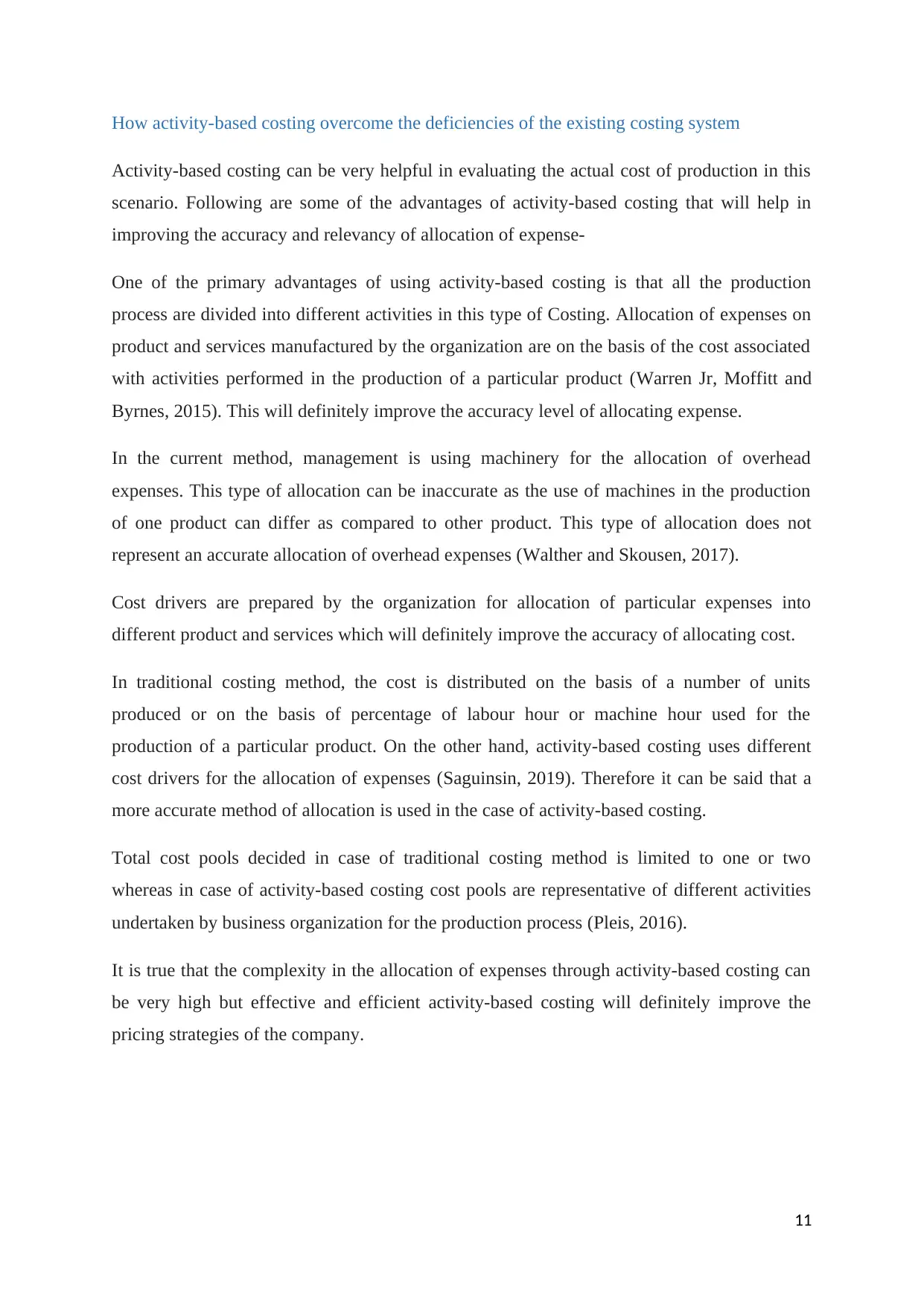
How activity-based costing overcome the deficiencies of the existing costing system
Activity-based costing can be very helpful in evaluating the actual cost of production in this
scenario. Following are some of the advantages of activity-based costing that will help in
improving the accuracy and relevancy of allocation of expense-
One of the primary advantages of using activity-based costing is that all the production
process are divided into different activities in this type of Costing. Allocation of expenses on
product and services manufactured by the organization are on the basis of the cost associated
with activities performed in the production of a particular product (Warren Jr, Moffitt and
Byrnes, 2015). This will definitely improve the accuracy level of allocating expense.
In the current method, management is using machinery for the allocation of overhead
expenses. This type of allocation can be inaccurate as the use of machines in the production
of one product can differ as compared to other product. This type of allocation does not
represent an accurate allocation of overhead expenses (Walther and Skousen, 2017).
Cost drivers are prepared by the organization for allocation of particular expenses into
different product and services which will definitely improve the accuracy of allocating cost.
In traditional costing method, the cost is distributed on the basis of a number of units
produced or on the basis of percentage of labour hour or machine hour used for the
production of a particular product. On the other hand, activity-based costing uses different
cost drivers for the allocation of expenses (Saguinsin, 2019). Therefore it can be said that a
more accurate method of allocation is used in the case of activity-based costing.
Total cost pools decided in case of traditional costing method is limited to one or two
whereas in case of activity-based costing cost pools are representative of different activities
undertaken by business organization for the production process (Pleis, 2016).
It is true that the complexity in the allocation of expenses through activity-based costing can
be very high but effective and efficient activity-based costing will definitely improve the
pricing strategies of the company.
11
Activity-based costing can be very helpful in evaluating the actual cost of production in this
scenario. Following are some of the advantages of activity-based costing that will help in
improving the accuracy and relevancy of allocation of expense-
One of the primary advantages of using activity-based costing is that all the production
process are divided into different activities in this type of Costing. Allocation of expenses on
product and services manufactured by the organization are on the basis of the cost associated
with activities performed in the production of a particular product (Warren Jr, Moffitt and
Byrnes, 2015). This will definitely improve the accuracy level of allocating expense.
In the current method, management is using machinery for the allocation of overhead
expenses. This type of allocation can be inaccurate as the use of machines in the production
of one product can differ as compared to other product. This type of allocation does not
represent an accurate allocation of overhead expenses (Walther and Skousen, 2017).
Cost drivers are prepared by the organization for allocation of particular expenses into
different product and services which will definitely improve the accuracy of allocating cost.
In traditional costing method, the cost is distributed on the basis of a number of units
produced or on the basis of percentage of labour hour or machine hour used for the
production of a particular product. On the other hand, activity-based costing uses different
cost drivers for the allocation of expenses (Saguinsin, 2019). Therefore it can be said that a
more accurate method of allocation is used in the case of activity-based costing.
Total cost pools decided in case of traditional costing method is limited to one or two
whereas in case of activity-based costing cost pools are representative of different activities
undertaken by business organization for the production process (Pleis, 2016).
It is true that the complexity in the allocation of expenses through activity-based costing can
be very high but effective and efficient activity-based costing will definitely improve the
pricing strategies of the company.
11
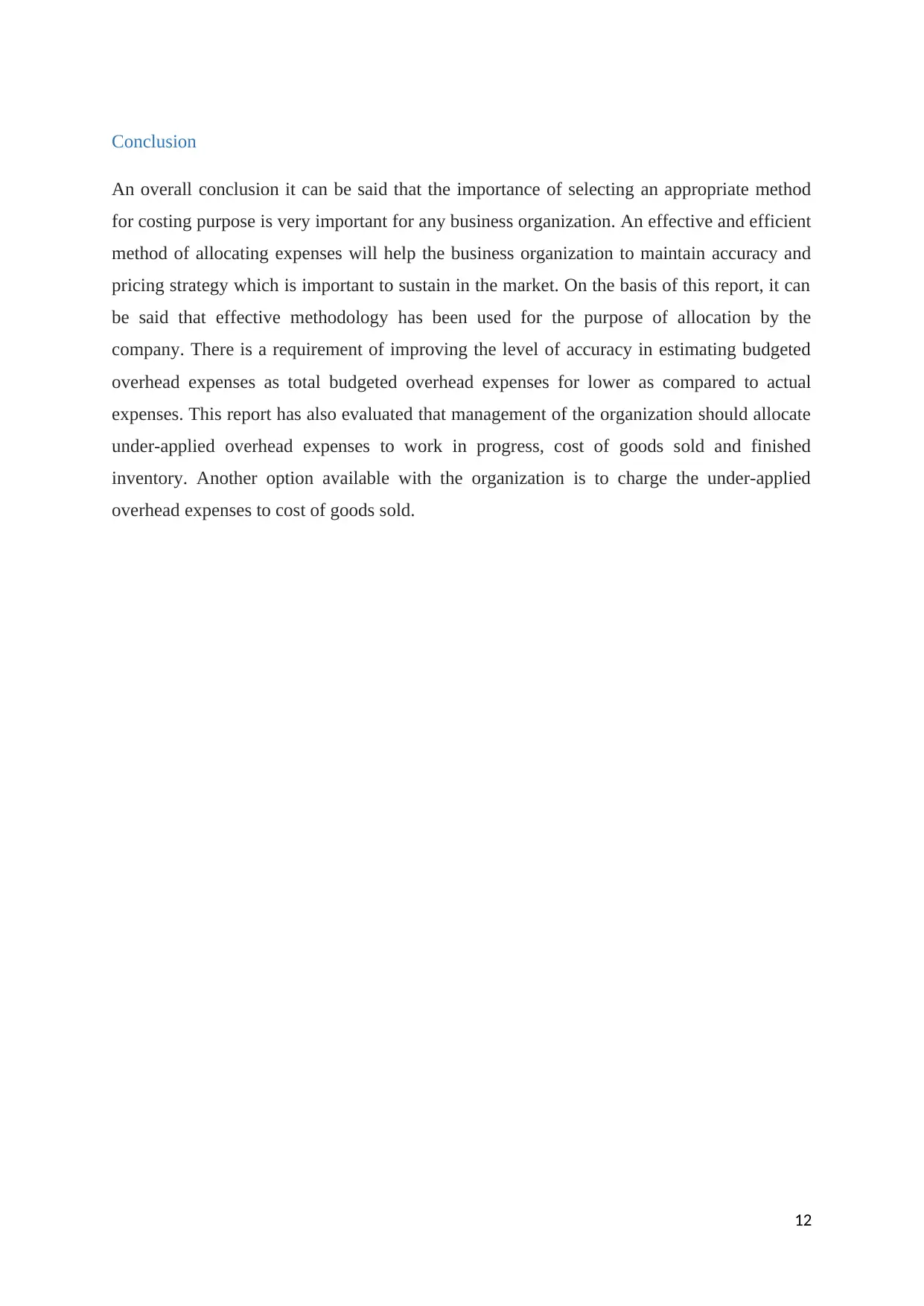
Conclusion
An overall conclusion it can be said that the importance of selecting an appropriate method
for costing purpose is very important for any business organization. An effective and efficient
method of allocating expenses will help the business organization to maintain accuracy and
pricing strategy which is important to sustain in the market. On the basis of this report, it can
be said that effective methodology has been used for the purpose of allocation by the
company. There is a requirement of improving the level of accuracy in estimating budgeted
overhead expenses as total budgeted overhead expenses for lower as compared to actual
expenses. This report has also evaluated that management of the organization should allocate
under-applied overhead expenses to work in progress, cost of goods sold and finished
inventory. Another option available with the organization is to charge the under-applied
overhead expenses to cost of goods sold.
12
An overall conclusion it can be said that the importance of selecting an appropriate method
for costing purpose is very important for any business organization. An effective and efficient
method of allocating expenses will help the business organization to maintain accuracy and
pricing strategy which is important to sustain in the market. On the basis of this report, it can
be said that effective methodology has been used for the purpose of allocation by the
company. There is a requirement of improving the level of accuracy in estimating budgeted
overhead expenses as total budgeted overhead expenses for lower as compared to actual
expenses. This report has also evaluated that management of the organization should allocate
under-applied overhead expenses to work in progress, cost of goods sold and finished
inventory. Another option available with the organization is to charge the under-applied
overhead expenses to cost of goods sold.
12
⊘ This is a preview!⊘
Do you want full access?
Subscribe today to unlock all pages.

Trusted by 1+ million students worldwide
1 out of 13
Related Documents
Your All-in-One AI-Powered Toolkit for Academic Success.
+13062052269
info@desklib.com
Available 24*7 on WhatsApp / Email
![[object Object]](/_next/static/media/star-bottom.7253800d.svg)
Unlock your academic potential
Copyright © 2020–2025 A2Z Services. All Rights Reserved. Developed and managed by ZUCOL.




